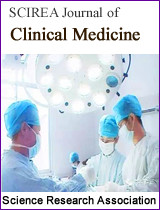Pattern and Clinical Outcome of Poisoning Cases Admitted in Emergency Department of a Tertiary Care Center at High Altitude Nepal.
DOI: 10.54647/cm321050 108 Downloads 13467 Views
Author(s)
Abstract
Introduction:Poisoning is one of the major health problems not only for the respective nation but also globally. Globally it has more impact on mortality and morbidity. According to WHO 2021 mortality rate of Nepal due to unintentional poisoning is 1.66 per one lakh population.(1) The objective of this study is to know the pattern and clinical outcome of oral poisoning in the high altitude of Nepal.
Methods: This is retrospective observational study done in the emergency of Karnali Academy of Health Sciences (KAHS), Jumla. The data was taken from 2021 July to 2022 July. Data was collected by reviewing the record file from data store of KAHS. Data entry was done in excel sheet followed by its analysis.
Results: Out of total 8163 patients visited in one year 74 (0.90%) was of poisoning cases in the year July 2021 to 2022 July. Most of the poisoning cases were seen in the age group between 11-20 i.e. 41.89%. Zinc phosphide (33.78%) was found to be the most common type of poisoning followed by an herbal compound (10.81%) named Coriaria nepalensis locally called as Machhaino. Maximum case overload was seen in the month of May-June. Out of 74 only 26 (35.13%) went through psychiatry evaluation. Out of 26 cases psychiatry evaluation 20 were suffering from mental disorder. The most common mental health disorder was suffering from depression (60%). In 46% suicidal tendency was found. 58 (78.37%) were discharged at the end of hospital stay and total death was 3 (4.05%).
Conclusion: The poisoning pattern is different in different part of world. Multidimensional approach is needed to address the problem related to poisoning. Most of the poisoning cases are associated with mental health disorder.
Keywords
Pattern of poisoning, mental health issues, outcome.
Cite this paper
Tula Krishna Gupta, Smriti Mayur Kasaudhan, Vivek Paudyal, Anusmriti Pal, Kushal Bhattarai, Grishma Shrestha, Rajiv Shah, Abdullah Rain,
Pattern and Clinical Outcome of Poisoning Cases Admitted in Emergency Department of a Tertiary Care Center at High Altitude Nepal.
, SCIREA Journal of Clinical Medicine.
Volume 8, Issue 2, April 2023 | PP. 130-140.
10.54647/cm321050
References
| [ 1 ] | Mortality rate attributed to unintentional poisoning (per 100 000 population). https://www.who.int/data/gho/data/themes/topics/indicator-groups/poison-control-and-unintentional-poisoning [Accessed 16th March 2023]. |
| [ 2 ] | Dayasiri MBKC, Jayamanne SF, Jayasinghe CY. Risk Factors for Acute Unintentional Poisoning among Children Aged 1–5 Years in the Rural Community of Sri Lanka. International Journal of Pediatrics. 2017;2017: 1–9. https://doi.org/10.1155/2017/4375987. |
| [ 3 ] | Woyessa AH, Palanichamy T. Patterns, Associated Factors, and Clinical Outcomes of Poisoning among Poisoning Cases Presented to Selected Hospitals in Western Ethiopia: Hospital-Based Study. Emergency Medicine International. 2020;2020: 1–9. https://doi.org/10.1155/2020/5741692. |
| [ 4 ] | View of Acute poisoning cases in emergency department of tertiary level hospital, Kathmandu. http://nepmed.nhrc.gov.np/index.php/jgpeman/article/view/1051/878 [Accessed 16th March 2023]. |
| [ 5 ] | Adinew GM, Asrie AB, Birru EM. Pattern of acute organophosphorus poisoning at University of Gondar Teaching Hospital, Northwest Ethiopia. BMC Research Notes. 2017;10(1): 1–6. https://doi.org/10.1186/S13104-017-2464-5/TABLES/2. |
| [ 6 ] | Woyessa AH, Palanichamy T. Patterns, Associated Factors, and Clinical Outcomes of Poisoning among Poisoning Cases Presented to Selected Hospitals in Western Ethiopia: Hospital-Based Study. Emergency Medicine International. 2020;2020: 1–9. https://doi.org/10.1155/2020/5741692. |
| [ 7 ] | Hettiarachchi J, Kodithuwakku GCS. Pattern of Poisoning in Rural Sri Lanka. International Journal of Epidemiology. 1989;18(2): 418–422. https://doi.org/10.1093/IJE/18.2.418. |
| [ 8 ] | Jalali S, Khan SH, Jan FA, Jalali I. Study of Profile, Pattern and Outcome of Oral Poisoning Cases admitted in Emergency Department of a Tertiary Care Teaching Hospital in North India. JMS SKIMS. 2018;21(1): 24–30. https://doi.org/10.33883/JMS.V21I1.348. |
| [ 9 ] | Prashar A, Ramesh M. Assessment of pattern and outcomes of pesticides poisoning in a tertiary care hospital. Tropical Medicine & International Health. 2018;23(12): 1401–1407. https://doi.org/10.1111/TMI.13156. |
| [ 10 ] | Mittal C, Singh S, Kumar-M P, Varthya SB. Toxicoepidemiology of poisoning exhibited in Indian population from 2010 to 2020: a systematic review and meta-analysis. BMJ Open. 2021;11(5): e045182. https://doi.org/10.1136/BMJOPEN-2020-045182. |
| [ 11 ] | Gunnell D, Eddleston M, Phillips MR, Konradsen F. The global distribution of fatal pesticide self-poisoning: Systematic review. BMC Public Health. 2007;7(1): 1–15. https://doi.org/10.1186/1471-2458-7-357/TABLES/2. |
| [ 12 ] | Anthony L, Kulkarni C. Patterns of poisoning and drug overdosage and their outcome among in-patients admitted to the emergency medicine department of a tertiary care hospital. Indian Journal of Critical Care Medicine : Peer-reviewed, Official Publication of Indian Society of Critical Care Medicine. 2012;16(3): 130. https://doi.org/10.4103/0972-5229.102070. |
| [ 13 ] | Suicide. https://www.who.int/news-room/fact-sheets/detail/suicide [Accessed 17th March 2023]. |
| [ 14 ] | Khudair IF, Jassim Z, Hanssens Y, Alsaad WA. Characteristics and determinants of adult patients with acute poisoning attending the accident and emergency department of a teaching hospital in Qatar. Human and Experimental Toxicology. 2013;32(9): 921–929. https://doi.org/10.1177/0960327113479043/ASSET/IMAGES/LARGE/10.1177_0960327113479043-FIG1.JPEG. |
| [ 15 ] | Dayasiri K, Jayamanne SF, Jayasinghe CY. Accidental and Deliberate Self-Poisoning with Medications and Medication Errors among Children in Rural Sri Lanka. Emergency Medicine International. 2020;2020: 1–8. https://doi.org/10.1155/2020/9872821. |
| [ 16 ] | Gjelsvik B, Heyerdahl F, Holmes J, Lunn D, Hawton K. Looking Back on Self-Poisoning: The Relationship between Depressed Mood and Reporting of Suicidal Intent in People Who Deliberately Self-Poison. Suicide & life-threatening behavior. 2017;47(2): 228–241. https://doi.org/10.1111/SLTB.12278. |
| [ 17 ] | Rasimas JJ, Carter GL. Psychiatric issues in the critically poisoned patient. Critical Care Toxicology: Diagnosis and Management of the Critically Poisoned Patient. 2017; 117–157. https://doi.org/10.1007/978-3-319-17900-1_44/COVER. |

